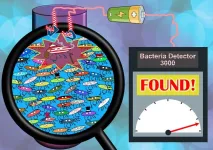(Press-News.org) In recent years, the U.S. government has invested substantially in Federally Qualified Health Centers (FQHCs), which have become synonymous in policy discussions with primary care for the socially vulnerable. Conversely, no such investment has been made in independent practices serving socially vulnerable patients. As independent practices become less financially viable, this disparity could severely limit primary care options for socially vulnerable patients. This mixed-methods study considers the extent to which independent family physicians in urban communities serve socially vulnerable patients and aims to better understand their practices, challenges, and the structural supports that could better facilitate their patient care.
Quantitative analysis of data from the 2017-2020 American Board of Family Medicine’s (ABFM) Family Medicine Certification Examination questionnaire, a mandatory component of family medicine recertification, showed that 19.3% of family physicians in urban areas, down from 22.6% in 2017, served in independent practices with one to five clinicians. Nearly half of them reported that more than 10% of their patients were socially vulnerable. For the qualitative portion of the study, researchers conducted one-hour semi-structured virtual interviews with 22 physicians who, per their ABFM questionnaires, met the following inclusion criteria: (1) their principal practice site is independently owned; (2) they are its sole or partial owner; (3) their practice has one to five providers; (4) their practice is in an urban area; and (5) more than 50% of their patients are socially vulnerable. The results of the interviews revealed five themes: (1) substantial time is spent addressing access issues and social determinants of health; (2) these practices receive minimal support from health care entities such as independent practice associations and health plans and have insufficient connections with community-based organizations; (3) they face myriad financial challenges; (4) they have serious concerns about their future; and (5) their physicians hold a deep personal commitment to serving socially vulnerable patients in independent practice. The researchers conclude that health equity–focused policies could decrease the burden on these physicians and bolster independent practices so that socially vulnerable patients will continue to have options when seeking primary care.
What We Know: Historically, primary care for socially vulnerable populations has depended on a fragmented “safety net” of public hospitals, health centers, and other health care organizations that provide care regardless of whether patients can pay. In recent years, the federal government has provided substantial funding to large FQHCs to care for the socially vulnerable, though no equivalent investment has been made in independent practices. Consequently, such practices are at risk of closure, even though many physicians and patients still prefer smaller, independent practice settings.
What This Study Adds: This study provides rich insights from independent primary care physicians serving socially vulnerable patients, a perspective that is underrepresented in the literature. While the multidisciplinary research team focused on urban communities, their findings might also be relevant to small independent rural practices. They propose that public policy focused on health equity, new primary care payment models that increase payments to independent practices, and new workforce policies that encourage recruitment and retention of small practice primary care teams could help these practices stay afloat.
Small Independent Primary Care Practices Serving Socially Vulnerable Urban Populations
Diane R. Rittenhouse, MD, MPH, et al
Mathematica, Oakland, California
PRE-EMBARGO LINK (Link expires at 5 p.m. EDT March 25, 2024)
PERMANENT LINK
END
The future of independent primary care practices serving vulnerable populations depends on new policies that support health equity
In recent years, the U.S. government has invested substantially in Federally Qualified Health Centers (FQHCs), which have become synonymous in policy discussions with primary care for the socially vulnerable.
2024-03-25
ELSE PRESS RELEASES FROM THIS DATE:
Comparative study of type 2 diabetes medications show differences in medication acceptance, quality-of-life, insulin secretion and mortality
2024-03-25
Diabetes affects more than 1 in 10 — or more than 38 million — Americans. People with diabetes who keep their blood sugar levels in the near-normal range generally have a much lower risk of developing diabetes complications such as heart, kidney, and eye diseases. The challenge is that most people with diabetes require more than one medication to control blood sugar levels over time.
The Glycemia Reduction Approaches in Diabetes: A Comparative Effectiveness, or GRADE, Study was designed to compare ...
Research identifies characteristics of cities that would support young people’s mental health
2024-03-25
As cities around the world continue to draw young people for work, education, and social opportunities, a new study identifies characteristics that would support young urban dwellers’ mental health. The findings, based on survey responses from a global panel that included adolescents and young adults, provide a set of priorities that city planners can adopt to build urban environments that are safe, equitable, and inclusive.
To determine city characteristics that could bolster youth mental health, researchers administered an initial survey to a panel of more than 400, including young people ...
C-Path to spearhead new task force dedicated to accelerating drug development for progressive supranuclear palsy
2024-03-25
TUCSON, Ariz., March 25, 2024 — Critical Path Institute (C-Path) today announced the formation of a new task force under its Rare Disease Cures Accelerator-Data and Analytics Platform (RDCA-DAP®), dedicated to advancing therapeutic development for Progressive Supranuclear Palsy (PSP). This initiative brings together leading organizations and experts in a concerted effort to tackle the challenges associated with PSP drug development. PSP is a brain disorder that affects movement, control of walking and balance, speech, swallowing, vision, mood, behavior and thought.
The confirmed members of the task force ...
SFU professor leads global roadmap to advance printable sensors for sustainability and quality of lif
2024-03-25
A Simon Fraser University professor is helping make strides towards a “sustainable, intelligent world” by propelling printable sensor technologies.
Vincenzo Pecunia, from SFU’s School of Sustainable Energy Engineering, led a team of more than 100 experts from 57 research institutions worldwide in developing a comprehensive roadmap for next-generation printable sensor technologies. By paving the way for everyday objects and environments to acquire sensing capabilities, these technologies could be a game changer in advancing sustainability and enhancing our quality ...
ORNL helping Roll-to-Roll Consortium scale up hydrogen technology
2024-03-25
The Department of Energy’s Oak Ridge National Laboratory is providing national leadership in a new collaboration among five national laboratories to accelerate U.S. production of clean hydrogen fuel cells and electrolyzers.
Hydrogen fuel cells provide power to electric vehicles and buildings using an electrochemical reaction that converts hydrogen and oxygen into heat, water and electricity. The Roll-to-Roll, or R2R, Consortium aims to scale up, speed up and reduce the cost of producing key components ...
Research news from the Ecological Society of America’s journals
2024-03-25
The Ecological Society of America (ESA) presents a roundup of five research articles recently published across its six esteemed journals. Widely recognized for fostering innovation and advancing ecological knowledge, ESA’s journals consistently feature innovative and impactful studies. This compilation of papers explores invasive possum management in New Zealand, afforestation on global rangelands, population regulation in large herbivores and more, showcasing the Society’s commitment to promoting cutting-edge research that furthers ...
ASU Regents Professor inducted into 2024 class of AIMBE College of Fellows
2024-03-25
The American Institute for Medical and Biological Engineering (AIMBE) has announced the induction of Regents Professor Petra Fromme, director of the Biodesign Center for Applied Structural Discovery at Arizona State University, to its College of Fellows.
Election to the AIMBE College of Fellows is among the highest professional distinctions accorded to medical and biological engineers, an honor reserved only for the top 2% of researchers in these fields.
"We welcome Petra's well-earned induction into ...
Novel electrochemical sensor detects dangerous bacteria
2024-03-25
Each year, bacterial infections claim several million lives worldwide. That is why detecting harmful microorganisms is crucial – not only in the diagnosis of diseases but also, for example, in food production. However, the methods available so far are often time-consuming, require expensive equipment or can only be used by specialists. Moreover, they are often unable to distinguish between active bacteria and their decay products.
By contrast, the newly developed method detects only intact bacteria. It makes use of the fact that ...
Cancer therapies show promise in combating tuberculosis
2024-03-25
EMBARGOED UNTIL MARCH 25, 2024 AT 3:00 PM US EST
What could cancer teach us about tuberculosis? That’s a question Meenal Datta has been chasing since she was a graduate student.
Once the body’s immune system is infected with tuberculosis, it forms granulomas — tight clusters of white blood cells — in an attempt to wall off the infection-causing bacteria in the lungs. But more often than not, granulomas do more harm than good.
Charged with analyzing the similarities between granulomas and tumors, Datta discovered that both are structurally and functionally abnormal. ...
Gotta go? New bladder device lets you know
2024-03-25
Should you run to the bathroom now? Or can you hold it until you get home? A new implant and associated smartphone app may someday remove the guess work from the equation.
Northwestern University researchers have developed a new soft, flexible, battery-free implant that attaches to the bladder wall to sense filling. Then, it wirelessly — and simultaneously — transmits data to a smartphone app, so users can monitor their bladder fullness in real time.
The study will be published next week in the Proceedings of the National Academy of Sciences (PNAS). It ...
LAST 30 PRESS RELEASES:
Injectable breast ‘implant’ offers alternative to traditional surgeries
Neuroscientists devise formulas to measure multilingualism
New prostate cancer trial seeks to reduce toxicity without sacrificing efficacy
Geometry shapes life
A CRISPR screen reveals many previously unrecognized genes required for brain development and a new neurodevelopmental disorder
Hot flush treatment has anti-breast cancer activity, study finds
Securing AI systems against growing cybersecurity threats
Longest observation of an active solar region
Why nail-biting, procrastination and other self-sabotaging behaviors are rooted in survival instincts
Regional variations in mechanical properties of porcine leptomeninges
Artificial empathy in therapy and healthcare: advancements in interpersonal interaction technologies
Why some brains switch gears more efficiently than others
UVA’s Jundong Li wins ICDM’S 2025 Tao Li Award for data mining, machine learning
UVA’s low-power, high-performance computer power player Mircea Stan earns National Academy of Inventors fellowship
Not playing by the rules: USU researcher explores filamentous algae dynamics in rivers
Do our body clocks influence our risk of dementia?
Anthropologists offer new evidence of bipedalism in long-debated fossil discovery
Safer receipt paper from wood
Dosage-sensitive genes suggest no whole-genome duplications in ancestral angiosperm
First ancient human herpesvirus genomes document their deep history with humans
Why Some Bacteria Survive Antibiotics and How to Stop Them - New study reveals that bacteria can survive antibiotic treatment through two fundamentally different “shutdown modes”
UCLA study links scar healing to dangerous placenta condition
CHANGE-seq-BE finds off-target changes in the genome from base editors
The Journal of Nuclear Medicine Ahead-of-Print Tip Sheet: January 2, 2026
Delayed or absent first dose of measles, mumps, and rubella vaccination
Trends in US preterm birth rates by household income and race and ethnicity
Study identifies potential biomarker linked to progression and brain inflammation in multiple sclerosis
Many mothers in Norway do not show up for postnatal check-ups
Researchers want to find out why quick clay is so unstable
Superradiant spins show teamwork at the quantum scale
[Press-News.org] The future of independent primary care practices serving vulnerable populations depends on new policies that support health equityIn recent years, the U.S. government has invested substantially in Federally Qualified Health Centers (FQHCs), which have become synonymous in policy discussions with primary care for the socially vulnerable.





